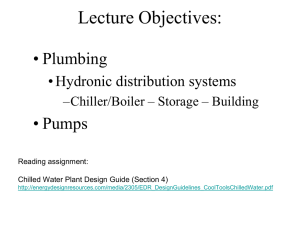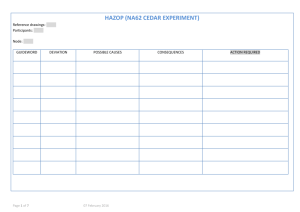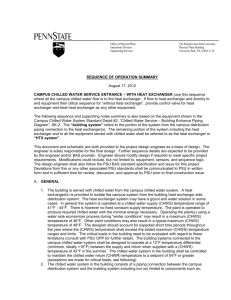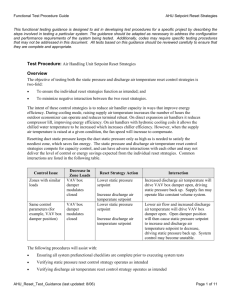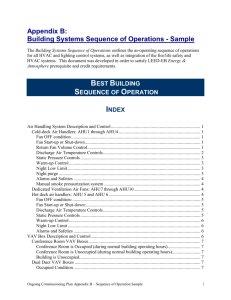Pump System Assessment Guidance (MS Word)
advertisement
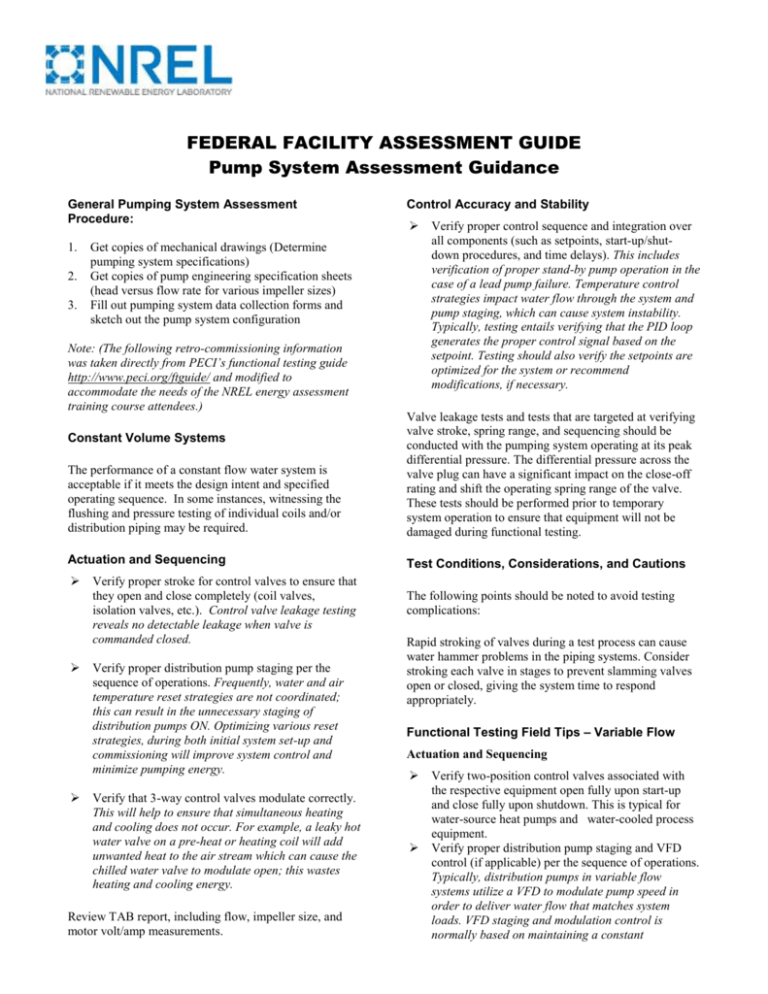
FEDERAL FACILITY ASSESSMENT GUIDE Pump System Assessment Guidance General Pumping System Assessment Procedure: 1. 2. 3. Control Accuracy and Stability Get copies of mechanical drawings (Determine pumping system specifications) Get copies of pump engineering specification sheets (head versus flow rate for various impeller sizes) Fill out pumping system data collection forms and sketch out the pump system configuration Note: (The following retro-commissioning information was taken directly from PECI’s functional testing guide http://www.peci.org/ftguide/ and modified to accommodate the needs of the NREL energy assessment training course attendees.) Verify proper control sequence and integration over all components (such as setpoints, start-up/shutdown procedures, and time delays). This includes verification of proper stand-by pump operation in the case of a lead pump failure. Temperature control strategies impact water flow through the system and pump staging, which can cause system instability. Typically, testing entails verifying that the PID loop generates the proper control signal based on the setpoint. Testing should also verify the setpoints are optimized for the system or recommend modifications, if necessary. The performance of a constant flow water system is acceptable if it meets the design intent and specified operating sequence. In some instances, witnessing the flushing and pressure testing of individual coils and/or distribution piping may be required. Valve leakage tests and tests that are targeted at verifying valve stroke, spring range, and sequencing should be conducted with the pumping system operating at its peak differential pressure. The differential pressure across the valve plug can have a significant impact on the close-off rating and shift the operating spring range of the valve. These tests should be performed prior to temporary system operation to ensure that equipment will not be damaged during functional testing. Actuation and Sequencing Test Conditions, Considerations, and Cautions Constant Volume Systems Verify proper stroke for control valves to ensure that they open and close completely (coil valves, isolation valves, etc.). Control valve leakage testing reveals no detectable leakage when valve is commanded closed. Verify proper distribution pump staging per the sequence of operations. Frequently, water and air temperature reset strategies are not coordinated; this can result in the unnecessary staging of distribution pumps ON. Optimizing various reset strategies, during both initial system set-up and commissioning will improve system control and minimize pumping energy. Verify that 3-way control valves modulate correctly. This will help to ensure that simultaneous heating and cooling does not occur. For example, a leaky hot water valve on a pre-heat or heating coil will add unwanted heat to the air stream which can cause the chilled water valve to modulate open; this wastes heating and cooling energy. Review TAB report, including flow, impeller size, and motor volt/amp measurements. The following points should be noted to avoid testing complications: Rapid stroking of valves during a test process can cause water hammer problems in the piping systems. Consider stroking each valve in stages to prevent slamming valves open or closed, giving the system time to respond appropriately. Functional Testing Field Tips – Variable Flow Actuation and Sequencing Verify two-position control valves associated with the respective equipment open fully upon start-up and close fully upon shutdown. This is typical for water-source heat pumps and water-cooled process equipment. Verify proper distribution pump staging and VFD control (if applicable) per the sequence of operations. Typically, distribution pumps in variable flow systems utilize a VFD to modulate pump speed in order to deliver water flow that matches system loads. VFD staging and modulation control is normally based on maintaining a constant differential pressure either across the distribution pumps themselves or out in the loop. The differential pressure setpoint is based on the pressure required to provide adequate flow through the worst case load (for example, the load with the highest overall pressure drop piping losses and device requirements) at full load. Often, the setpoint (either specified by the design engineer or estimated by the controls contractor, if not provided) is set artificially high, wasting pumping energy for the life of the building. The actual system pressure setpoint should be determined during the initial system set-up and commissioning to improve system control and minimize pumping energy. Setpoints and Reset Controls The system operates and maintains chilled and hot water supply temperature setpoints and discharge air temperature setpoints in all modes including morning warm-up, occupied mode, and night low limit mode. VFD control loops generate the proper setpoint based on the reset parameters (if applicable). Reset parameters are optimized for the system. Verify differential pressure reset control strategy. Frequently, the discharge pressure setpoint is reset based on dynamic load requirements to reduce pump energy even further. Various indicators can be used to signify reduced load on the system, one example being valve position. In this control strategy, the system pressure setpoint is reset higher or lower in order to maintain one chilled water valve at a pre-set position (95% open, for example). Verify proper coordination between individual setpoints and reset strategies. Resetting the chilled water supply temperature warrants close attention. Without coordination between chilled water temperature reset and discharge air temperature reset, the air handler may be trying to make colder air than is possible with the chilled water supply temperature. This situation will result in distribution pumps operating at full flow even though there is no load on the system, wasting significant pumping energy.

